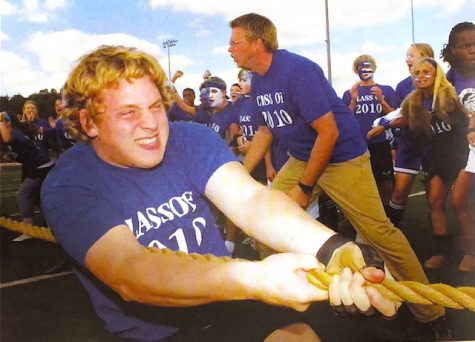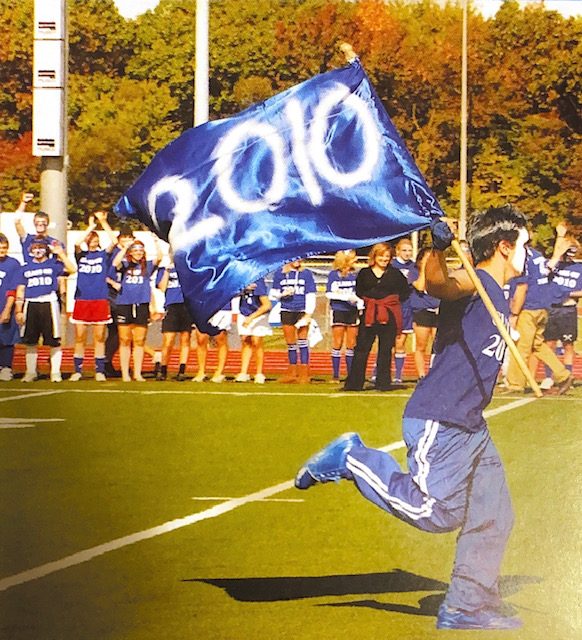To Revive Our Viking Part Two: the history of Spirit Week
The Class of 2010 lines the football field during the field events, proudly displaying their school spirit.
Raise your hand if you think that Eastern has school spirit.
Probably not that many of you would.
In the first part of the series, evidence showed that school spirit is important to foster passion for learning and establishing one’s identity with a supportive community.
However, Eastern has a comparatively low school spirit. Furthermore, it’s not that we don’t have school spirit, but we should have more. As we recover from the pandemic, it’s more important than ever to invest in the mental health of students by ensuring they have a community that supports them.
Eastern has the chance to unify clubs, extracurriculars, and their communities, altogether raising school spirit. But will they take it?
Spirit Week may have passed, but what about school spirit? It’s clear apathy plagues these halls, but at one time passion blazed through them. Now only embers remain; what happened? It didn’t always used to be like this.
Nearly a decade ago, excitement and Eastern intertwined into one week of intense competition between the four graduating classes every October. After a fun-filled week of theme days, it all culminated into one dramatic afternoon. Friday. Field events. Outside. Track events, pie-eating contests, tug of war, potato sack races, obstacle courses—you name it, it was fought for under the glory of the sun.
“It was like you were at the Olympics,” history teacher Mr. McAleer said.

The school day was even cut short in anticipation and dedication to these events. Each class would gather into one section of the bleachers donning their class T-shirts, creating four distinct Viking clans gathered in the raging seas to fight for victory.
It came down to the last event, the 4×100 meter relay on the track. It always riled the roars and cheers even louder in a tense showdown. In 2008, two-time Olympic medalist English Gardner and stand-out 800m runner Kasey Ritz took part in the Spirit Week relay for the Juniors; it was truly a crucial event to win.
With an environment as exhilarating as this, how did Spirit Week turn into what it is now?
It’s actually quite simple. The traditional feud between the senior and freshman class was just too much to handle. In a dramatic upset, the freshman class won Spirit Week nearly a decade ago.
Rage. That’s just one word to describe the disrespect that violently flooded the halls. “Tagging,” a normal activity for seniors to show their superiority by “coloring” underclassmen with markers quickly escalated to full-blown paint tubes—but not just on their shirts, now it went everywhere.
Bathrooms were defaced, as vibrant colors splattered the school in a display of rebellion, including school buses and the parking lot. Entire water balloons were filled to the brim with paint and found Dr. Tull’s jacket an easy target.
The chaos and destruction was so devastating that the perpetrators were immediately suspended if caught. Full day, in-school suspensions were put into effect, putting administrative study periods to shame.
Peace. But at what cost? The following year, field events disappeared. Only a few years ago did the administration approve the revival of indoor “field” events—now barely an echo of the excitement they used to be.

It’s clear there are sizable differences between school spirit before and after the incident. There are a number of factors that could have contributed to such results, like the advancement of technology and social media.
However, it’s reasonable to speculate that this incident is one of the primary reasons Eastern’s school spirit appears more apathetic in recent years. Mentioned in the first part of the series, a survey asked students to rate their pride from one to ten (one being absolutely none and ten being comparable to zealous pride), the average score was a five, indicative of the comparatively low school spirit Eastern has.
However, the results of the survey may also indirectly reveal the amount of effort Eastern has put in to facilitate a sense of pride within the school.
When asked to explain whether they think the majority of Eastern students have pride in our school today, Mrs. McBride said “No. I actually asked some students why this might be and their answer was ‘there is nothing to be proud of.”
While Spirit Week is not wholly to blame it, certainly has influence. The school withdraws from putting the same amount of effort into Spirit Week as before the incident, in order to prevent the recurrence of disastrous events. Now, future graduating classes suffer from the mistakes of their predecessors. Of course, Spirit Week is not the only indicator of school pride, but the amount of effort from administrators and teachers put towards planning and publicizing Spirit Week has fallen dramatically, likewise decreasing the sense of unity within the school.
It needs to be restored. For everyone’s sake.
However, it will take an effort from everyone to combat natural influences like the size of the school and the departmentalization of teachers, while connecting the Vikings in clubs, sports, and extracurriculars.
Mrs. Dibert, teacher of family and consumer science said, “When coming to school, it’s a place to not only learn, but to connect with others, to be a part of something bigger than yourself, to be a part of another family…your ‘school family.’ It’s a time to share your experiences and open yourself up to the ideas of others in your school community, so you can maximize your learning experience and time here in a positive way.”
What will it take to revive the Eastern Viking? This is what this series is all about. Stay tuned for To Revive Our Viking Part 3: The Factors.




